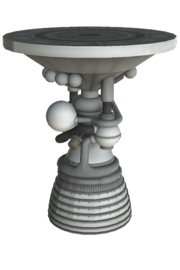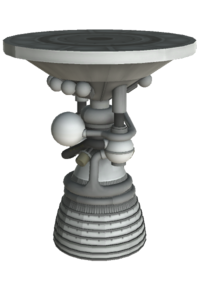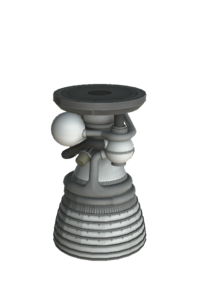Difference between revisions of "RE-I2 "Skiff" Liquid Fuel Engine"
Anaxagoras (talk | contribs) (add usage note, remove stub status) |
(→Trivia) |
||
| (One intermediate revision by one other user not shown) | |||
| Line 5: | Line 5: | ||
== Usage == | == Usage == | ||
| − | The Skiff is average or above average in each metric of engine performance. It is inexpensive and lightweight, has thrust vectoring, and | + | The Skiff is average or above average in each metric of engine performance. It is inexpensive and lightweight, it has thrust vectoring, and its thrust-to-weight ratio and [[specific impulse]] are both good (but not exceptional), both in atmosphere and in vacuum. |
| − | It does not excel in any single category; in some ways it is a "Jack of all trades, master of none." In rockets that solely use serial staging, for each of those stages, it is likely that another more specialized engine will outperform the Skiff. But when using parallel staging i.e. boosters, especially with [[Asparagus staging | fuel crossfeed]], the Skiff's versatility can give good performance at launch, after booster separation, and in orbit. This | + | It does not excel in any single category; in some ways it is a "Jack of all trades, master of none." In rockets that solely use serial staging, for each of those stages, it is likely that another more specialized engine will outperform the Skiff. But when using parallel staging i.e. boosters, especially with [[Asparagus staging | fuel crossfeed enabled]], the Skiff's versatility can give good performance at launch, after booster separation, and in orbit. This may allow for reducing the number of engines, thus reducing the cost and dry mass of the rocket. |
| + | |||
| + | As the lightest 2.5m engine, the Skiff can be useful for transporting relatively light but wide payloads which would be awkward or impossible to fit in smaller [[fairing]] sizes, like some small landers. Its combination of atmospheric and vacuum performance also make it competitive for operation in thin atmospheres like Duna's, as an alternative to vacuum-oriented engines or a more expensive cluster of [[T-1 Toroidal Aerospike "Dart" Liquid Fuel Engine|Dart]]s. | ||
The Skiff slots between the two most closely comparable engines, the [[LV-T45 "Swivel" Liquid Fuel Engine|Swivel]] and the [[RE-I5 "Skipper" Liquid Fuel Engine|Skipper]]. Relative to the Swivel, the Skiff gives 40% more thrust for less than 7% more weight, with better efficiency both in atmosphere and in vacuum. The Skipper gives more than double the thrust for 88% more mass, and improves on the Skiff's [[specific impulse]] in atmosphere, but comes with a correspondingly higher price and slightly lower efficiency in vacuum. | The Skiff slots between the two most closely comparable engines, the [[LV-T45 "Swivel" Liquid Fuel Engine|Swivel]] and the [[RE-I5 "Skipper" Liquid Fuel Engine|Skipper]]. Relative to the Swivel, the Skiff gives 40% more thrust for less than 7% more weight, with better efficiency both in atmosphere and in vacuum. The Skipper gives more than double the thrust for 88% more mass, and improves on the Skiff's [[specific impulse]] in atmosphere, but comes with a correspondingly higher price and slightly lower efficiency in vacuum. | ||
| − | |||
== Product description == | == Product description == | ||
| Line 31: | Line 32: | ||
== Trivia == | == Trivia == | ||
| − | |||
=== Real-world comparison === | === Real-world comparison === | ||
| − | The Skiff was inspired by the American [[w:Rocketdyne J-2|J-2 engine]]. | + | The Skiff was inspired by the American [[w:Rocketdyne J-2|J-2 engine]], used for both the second and third stages of the [[w:Saturn V|Saturn V]]. |
| + | |||
| + | Though the Skiff's vacuum efficiency is slightly above average, it isn't high enough to make the claim in the product description very convincing. In particular, Making History also includes the [[RE-J10 "Wolfhound" Liquid Fuel Engine|Wolfhound]], which is far more efficient in vacuum and also has higher thrust, but is twice as heavy. The Wolfhound was modeled after the [[w:Apollo command and service module#Service_propulsion_system|Apollo Service Propulsion System]], which was the next stage of Apollo missions after the third stage's J-2, and had a much lower mass and specific impulse than the efficient and powerful J-2. So [https://forum.kerbalspaceprogram.com/index.php?/topic/172401-the-wolfhound-and-the-skiffs-stats-seem-to-be-switched/| some forum users speculated that perhaps Squad simply mistakenly swapped the two engines' stats, and the Skiff should have been the heavier, high-I<sub>sp</sub> engine]. However, Squad stated their intention was to make the Apollo SPS analogue a vacuum-specific engine, and swapped stats would still leave both engines quite different from their Apollo counterparts. | ||
| + | |||
| + | The differences only affect realism, especially when trying to build and fly a replica Apollo mission. Both parts were significantly adjusted for gameplay balance in version 1.6. | ||
| + | ===In-Game Similarities=== | ||
| + | |||
| + | The RE-I2 engine has an uncanny resemblance to the single bell variant of the [[RE-L10 "Poodle" Liquid Fuel Engine]]. It is unknown if this is intentional or not. | ||
== Changes == | == Changes == | ||
Latest revision as of 18:58, 31 October 2023
| Available only with the Making History Expansion installed. |
| RE-I2 "Skiff" Liquid Fuel Engine | ||
| Liquid fuel engine by Rockomax Conglomerate | ||
| Radial size | Large, Radial mounted | |
| Cost | (total) | 2 300.00 |
| Mass | (total) | 1.600 t |
| Drag | 0.3-0.2 | |
| Max. Temp. | 2000 K | |
| Impact Tolerance | 7 m/s | |
| Research | | |
| Unlock cost | 9 200 | |
| Since version | 1.4.1 | |
| Part configuration | LiquidEngineRE-I2.cfg | |
| Maximum thrust | (1 atm) | 240.91 kN |
| (vacuum) | 300.00 kN | |
| Isp | (1 atm) | 265 s |
| (vacuum) | 330 s | |
| Fuel consumption | 18.54 | |
| Thrust vectoring | 2 ° | |
| Electricity generated | 3.0 ⚡/s | |
| Testing Environments | ||
| On the surface | Yes | |
| In the ocean | Yes | |
| On the launchpad | Yes | |
| In the atmosphere | Yes | |
| Sub-orbital | Yes | |
| In an orbit | Yes | |
| On an escape | Yes | |
| Docked | No | |
| Test by staging | Yes | |
| Manually testable | Yes | |
| Packed volume | None | |
The RE-I2 "Skiff" Liquid Fuel Engine is a relatively light and versatile 2.5m or 1.875m sustainer-type liquid fuel engine.
Contents
Usage
The Skiff is average or above average in each metric of engine performance. It is inexpensive and lightweight, it has thrust vectoring, and its thrust-to-weight ratio and specific impulse are both good (but not exceptional), both in atmosphere and in vacuum.
It does not excel in any single category; in some ways it is a "Jack of all trades, master of none." In rockets that solely use serial staging, for each of those stages, it is likely that another more specialized engine will outperform the Skiff. But when using parallel staging i.e. boosters, especially with fuel crossfeed enabled, the Skiff's versatility can give good performance at launch, after booster separation, and in orbit. This may allow for reducing the number of engines, thus reducing the cost and dry mass of the rocket.
As the lightest 2.5m engine, the Skiff can be useful for transporting relatively light but wide payloads which would be awkward or impossible to fit in smaller fairing sizes, like some small landers. Its combination of atmospheric and vacuum performance also make it competitive for operation in thin atmospheres like Duna's, as an alternative to vacuum-oriented engines or a more expensive cluster of Darts.
The Skiff slots between the two most closely comparable engines, the Swivel and the Skipper. Relative to the Swivel, the Skiff gives 40% more thrust for less than 7% more weight, with better efficiency both in atmosphere and in vacuum. The Skipper gives more than double the thrust for 88% more mass, and improves on the Skiff's specific impulse in atmosphere, but comes with a correspondingly higher price and slightly lower efficiency in vacuum.
Product description
| “ | The Skiff is well suited for local planet hopping. High vacuum efficiency for this powerful upper stage drive will get you further. — Rockomax Conglomerate |
” |
Variants
As of version 1.4.1 this engine has two models that can be switched in the editor. The Shrouded variant is radial size large, while the Bare variant is size medium.
Trivia
Real-world comparison
The Skiff was inspired by the American J-2 engine, used for both the second and third stages of the Saturn V.
Though the Skiff's vacuum efficiency is slightly above average, it isn't high enough to make the claim in the product description very convincing. In particular, Making History also includes the Wolfhound, which is far more efficient in vacuum and also has higher thrust, but is twice as heavy. The Wolfhound was modeled after the Apollo Service Propulsion System, which was the next stage of Apollo missions after the third stage's J-2, and had a much lower mass and specific impulse than the efficient and powerful J-2. So some forum users speculated that perhaps Squad simply mistakenly swapped the two engines' stats, and the Skiff should have been the heavier, high-Isp engine. However, Squad stated their intention was to make the Apollo SPS analogue a vacuum-specific engine, and swapped stats would still leave both engines quite different from their Apollo counterparts.
The differences only affect realism, especially when trying to build and fly a replica Apollo mission. Both parts were significantly adjusted for gameplay balance in version 1.6.
In-Game Similarities
The RE-I2 engine has an uncanny resemblance to the single bell variant of the RE-L10 "Poodle" Liquid Fuel Engine. It is unknown if this is intentional or not.
Changes
- Increased unlock cost from 4500 to 9200
- Increased cost from 1500 to 2300
- Increased mass from 1 to 1.6
- Increased crash tolerance from 6 to 7
- Added ModuleTestSubject
- Initial Release
| ||||||||||||||||||||||||||||||||||||||||||||||||||||||||||


